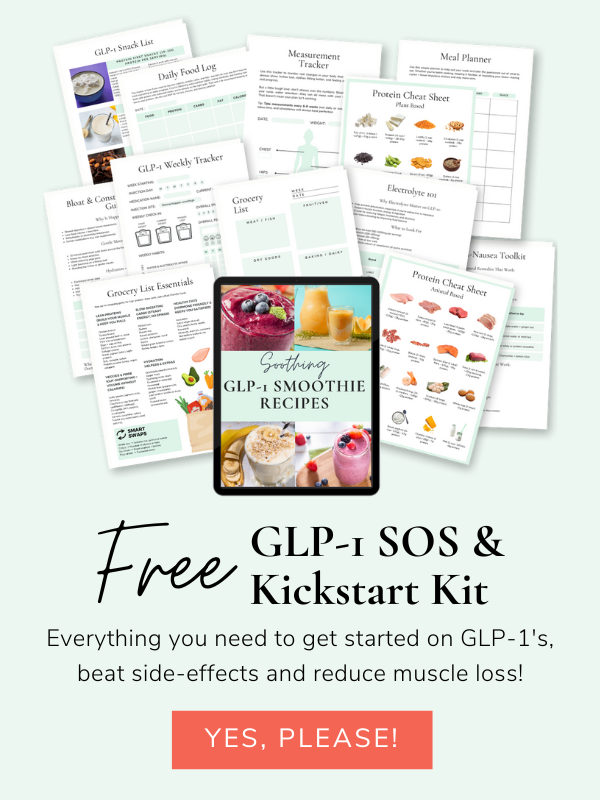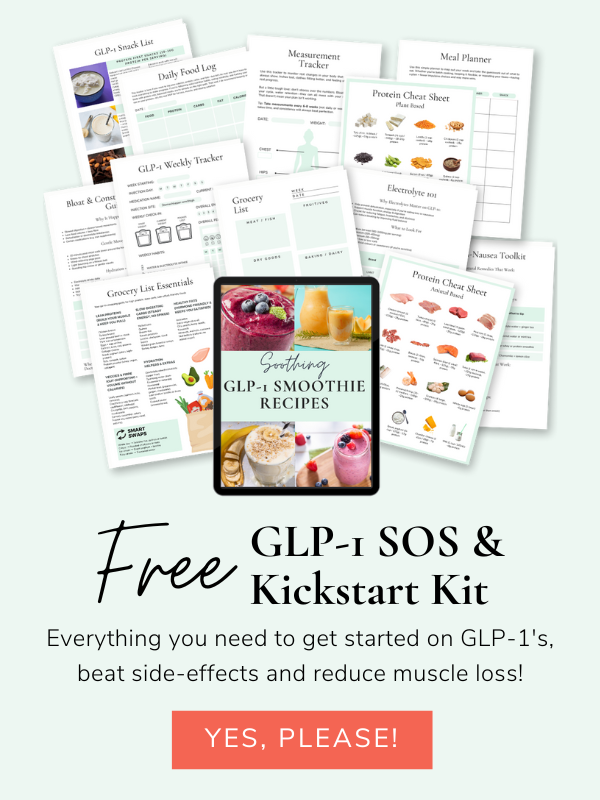This post may contain affiliate links, which means that I may earn a commission if you click on the link, with no cost for you. It’s one of the ways I support my blog. You can read more about this here.

“I thought losing weight would make me feel better… not like I’ve been hit by a bus.” Sound familiar? If you’re dragging yourself through the day on Wegovy, Ozempic, Mounjaro or any other semaglutide-based med, you’re not imagining it—GLP-1 fatigue is real, and it can make even the easiest tasks feel like climbing a mountain in flip-flops.
The good news? You’re not lazy, broken, or doing anything wrong.
Fatigue is one of the most common GLP-1 side effects—and it usually has a few sneaky root causes you can fix.
Whether you’re not eating enough, skipping electrolytes, or just feeling run down from adjusting to your semaglutide dosage chart, this post will help you get to the bottom of it and feel like you again.
We’re going to walk through why this energy crash happens, what your body might be missing, and how to build back your spark with small daily tweaks that actually work.
Let’s bring the energy back, one step at a time.
Why Am I So Tired on GLP-1 Medications?
If you’ve been wondering why your to-do list feels like a personal attack lately, here’s the deal: GLP-1 medications slow down your digestion and reduce your appetite.
That means less food, slower fuel, and often—less hydration too.
Add to that the adjustment period (especially in the first few weeks of a new semaglutide dosage) and your body’s basically going, “Excuse me—how are we supposed to run on empty?”
This isn’t just annoying—it impacts your daily life, your motivation, your workouts, and your ability to stay consistent.
Which, let’s face it, is the opposite of what you signed up for.
How Fatigue Impacts Your Weight Loss Journey
Here’s the vicious cycle:
You’re tired, so you move less.
You move less, so you feel even more sluggish.
You eat less (because the meds curb your appetite), which gives you even less energy.
Meanwhile, your muscles are like, “Erm, are we getting any protein today?”
GLP-1 fatigue doesn’t just affect your body—it messes with your head, too. That lack of energy can lead to low mood, poor sleep, and the dreaded “What’s the point?” spiral.
Recognising this isn’t weakness—it’s a smart step forward.
Fuel First: Nutrition That Powers You Through
This one’s not up for debate—if your tank’s empty, you’re going nowhere.
And I’m not talking about stuffing in a random cereal bar and hoping for the best.
Your energy thrives on protein, healthy fats, slow carbs, and micronutrients like iron, B12 and magnesium.
Many GLP-1 users forget that eating less means you’ve got to eat smarter. This is where nutrient-dense foods and GLP-1 supplements can make a massive difference.
Struggling with appetite loss or nausea? Blend a smoothie. Snack on Greek yoghurt. Add powdered protein to porridge or soup.
Fuel doesn’t have to be fancy—it just has to be intentional.
If you need more help – check out my completely FREE GLP-1 7-Day meal Plan or head over to the GLP-1 Nutrition posts for everything food related – snacks, meal prep, recipes and more.
Hydration Matters More Than You Think
Let’s have a word about water. Yes, it’s important. But if you’re only drinking plain water and skipping electrolytes, your body can’t use that water properly—and you’ll still feel knackered.
Low sodium, potassium or magnesium levels = tired, sluggish, foggy.
Start your day with a glass of water mixed with a quality electrolyte powder (ideally without artificial sweeteners—some of those make bloating worse).
And keep sipping throughout the day, especially if you’re dealing with dry mouth or constipation too.
Movement That Boosts Energy Instead of Draining It
I know what you’re thinking: “I can barely stand up, and now you want me to move?”
Yes—but hear me out.
You don’t need to go full beast mode. A short walk, a bit of stretching, or even dancing around your kitchen like no one’s watching can boost your energy without draining you.
It increases circulation, improves digestion, and gives you a cheeky endorphin kick.
Think of it as energy creation, not energy expenditure. Plus, regular movement supports better sleep—which we’re about to get into.
Supplements & Sleep Hacks That Work Together
Let’s talk tactical support.
If you’re tired all the time, check your iron and B12 levels. Magnesium glycinate can be brilliant for both sleep and muscle function.
And if your stress levels are off the charts, consider adaptogens like ashwagandha or rhodiola (always double check with your GP or pharmacist, especially if you’re on other meds). You can find out more of the best supplements on GLP-1 here.
Now, onto sleep. If you’re not sleeping well, fatigue is inevitable. Stick to a wind-down routine: no screens late at night, keep your room dark and cool, and try a calming tea (chamomile or valerian root) to help your body chill the heck out.
You Might Also Like:
- GLP-1 Nausea Relief: Easy Tips to Calm Your Stomach
- GLP-1 Constipation Relief: How to Stay Regular Without Feeling Miserable
- GLP-1 Dry Mouth and Dehydration: Stay Refreshed and Hydrated
- GLP-1 Hair Loss Prevention: 9 Essential Tips to Keep Your Hair Healthy
Your GLP-1 Game Plan Starts Here
Feeling a bit lost on your GLP-1 journey? Whether you’re just starting out or deep into your dose increases, the GLP-1 Success Blueprint is your practical, no-fluff guide to navigating weight loss meds like Mounjaro, Zepbound, or Wegovy with confidence.
This isn’t another generic ebook. It’s a full toolkit designed to help you feel strong, informed, and in control, without the overwhelm.

Inside, you’ll get:
- GLP-1 Meds 101: Understand how they work, what to expect, and how each med compares (minus the jargon)
- Nutrition Guidance: Learn how to eat for fat loss and muscle retention, even when your appetite is low
- Workout Support: Discover the best ways to move your body without burning out
- 6-Week Action Plan: Simple daily steps and healthy habit examples to follow at your pace
- Mindset & Motivation Tips: Stay consistent even when your drive dips
- Red Flag Checklist: Know what’s normal, what’s not, and when to seek support
- Bonus: Myths & FAQs – Bust the most common GLP-1 myths and get real answers
Digital download only – use it on your phone, tablet, or print it out to keep by your side.
Ready to ditch the guesswork and actually feel good on your meds?
Conclusion
GLP-1 fatigue might be common, but it doesn’t have to be your daily reality. With the right fuel, hydration, and gentle movement, your energy will come back. You’ve just got to give your body what it’s asking for.
You’re not failing—you’re adjusting. And that’s a powerful place to be.
Next Steps
“Energy flows where intention goes—start small and keep moving forward.”
Grab your free GLP-1 Starter Kit – it’s full of food ideas, supplement support, and daily tweaks to beat fatigue and feel your best.
Read This Next: GLP-1 Dry Mouth and Dehydration: Stay Refreshed and Hydrated
Or explore the full GLP-1 Side Effect Survival Guide for real-life relief across every symptom, without losing your mind (or your motivation).





